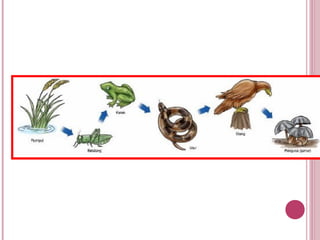
food and web chain
- 3. FEEDING RELATIONSHIPSFEEDING RELATIONSHIPS FOODCHAINS, FOODWEBFOODCHAINS, FOODWEB HEADINGS VOCABULARYVOCABULARY IMPORTANT INFO
- 4. KOMPETENSI INTI KI1 dan KI2: Menghargai dan menghayati ajaran agama yang dianutnya serta Menghargai dan menghayati perilaku jujur, disiplin, santun, percaya diri, peduli, dan bertanggung jawab dalam berinteraksi secara efektif sesuai dengan perkembangan anak di lingkungan, keluarga, sekolah, masyarakat dan lingkungan alam sekitar, bangsa, negara, dan kawasan regional. KI3: Memahami dan menerapkan pengetahuan faktual, konseptual, prosedural, dan metakognitif pada tingkat teknis dan spesifik sederhana berdasarkan rasa ingin tahunya tentang ilmu pengetahuan, teknologi, seni, budaya dengan wawasan kemanusiaan, kebangsaan, dan kenegaraan terkait fenomena dan kejadian tampak mata. KI4: Menunjukkan keterampilan menalar, mengolah, dan menyaji secara kreatif, produktif, kritis, mandiri, kolaboratif, dan komunikatif, dalam ranah konkret dan ranah abstrak sesuai dengan yang dipelajari di sekolah dan sumber lain yang sama dalam sudut pandang teori.
- 5. KOMPETENSI DASAR 3.7 Menganalisis interaksi antara makhluk hidup dan lingkungannya serta dinamika populasi akibat interaksi tersebut 4.7 Menyajikan hasil pengamatan terhadap interaksi makhluk hidup dengan lingkungan sekitarnya.
- 6. INDIKATOR KKM: 70 3.7.3 Menjelaskan pengertian interaksi. 3.7.4 Menjabarkan pola-pola interaksi. 3.7.5 Menjelaskan konsep bentuk saling ketergantungan makhluk hidup. 3.7.6 Menyebutkan perbedaan antara rantai makanan dengan jaring-jaring makanan, rantai makanan de tritus dengan rantai makanan perumput. 3.7.7 Memiliki keterampilan berbicara di depan kelas melalui kegiatan presentasi hasil eksplorasi. 4.7.1 Peserta didik dapat melakukan pengamatan lingkungan dan mengidentifikasi komponen biotik dan abiotik. 4.7.2 Peserta didik mampu mempresentasikan hail pengamatan mengenai konsep saling kebergantungan antar makhluk hidup.
- 7. FEEDING TYPES 1.1. AutotrophsAutotrophs: a. Self feeders, produce their own food through photosynthesisphotosynthesis Transformation of light energy to chemical energy to make food in the form of glucose a. Examples: plants, algae
- 8. 2.2. HeterotrophsHeterotrophs: a. Depend on other organisms for their food 1.1. HerbivoreHerbivore: Eats only plants 2.2. CarnivoreCarnivore: Eats only meat 3.3. OmnivoreOmnivore: Eats both plants and meat 4.4. DetrivoreDetrivore: Eats dead organisms
- 9. 3.3. DecomposersDecomposers: a. Break down and absorb nutrients from dead, decaying organisms b. Examples: mushrooms and bacteria
- 10. SymbiosisSymbiosis a. close, permanent relationship between organisms b. Three major types: 1. CommensalismCommensalism 2. MutualismMutualism 3. ParasitismParasitism 1) Mr. Fungus is ready to greet our friend the alga 2) Friend alga cell is prepared to greet Mr. Fungus 3) The Lichen is created between the fungus and the alga
- 11. FEEDING RELATIONSHIPS CommensalismCommensalism:: a. A feeding relationship in which one organism benefits and the other is not affected. b. Example: Remoras that live on or around a shark’s mouth. *Remora benefits from the scraps of food that fall from the shark’s mouth and the shark is not affected.
- 12. MutualismMutualism:: a. Both organisms benefit from the relationship b. “you scratch my back and I scratch yours” c. Example: tickbirds eat parasites off of the back of zebras. The tickbirds get fed and the zebra gets cleaned. ParasitismParasitism:: a. One organism benefits and the other is harmed b. Example: tapeworm living inside an organism’s intestine (may cause death) c. Example: flea living on a dog
- 13. WEBS 1.1. Food Chain:Food Chain: a. model showing the movement of energy through the ecosystem b. Consists of Producers, Consumers, and DecomposersProducers, Consumers, and Decomposers ProducerProducer:: living organisms that take non-living matter (like minerals and gases) from the environment and use them to support life (Example: plants). These are the first organisms in the food chain. ConsumerConsumer:: living things that need producers to be their food. EX: (Herbivores, carnivores, and omnivores) Decomposer:Decomposer: living things which feed off of dead plants and animals to reduce their remains to minerals and gases again http://magma.nationalgeographic.com/ngexplorer/0309/quickflicks/index.html
- 15. FOOD CHAINS AND FOOD WEBS 2. Food Web:Food Web: a. More complicated and more realistic than a food chain b. Shows more than one possible food source for each organism c. Steps in food chains or food webs are called trophic levelstrophic levels.. d.d. ProducersProducers make up the first trophic level e.e. ConsumersConsumers make up second, third, or higher.
- 16. • When you read a food chain or food web, the arrows point from what is being eaten to what it is eaten by (where the energy goes). Ex.: mouse snake; the mouse is EATEN BY the snake
- 17. KEY CONCEPT Pyramids model the distribution of energy and matter in an ecosystem.
- 18. energy transferred energy lost AN ENERGY PYRAMID SHOWS THE DISTRIBUTION OF ENERGY AMONG TROPHIC LEVELS. Energy pyramids compare energy used by producers and other organisms on trophic levels. • Between each tier of an energy pyramid, up to 90 percent of the energy is lost into the atmosphere as heat. • Only 10 percent of the energy at each tier is transferred from one trophic level to the next.
- 20. 1,000 kcal #1-WITH YOUR GROUP WORK TO ANSWER THE FOLLOWING QUESTION: If each level in a food chain typically loses 90% of the energy it takes in and the producer level uses 1000kcal of energy, how much of that energy is left after the third trophic level? 3rd level 2nd level How much remains for this level?
- 21. #2- WITH YOUR GROUP WORK TO ANSWER THE FOLLOWING QUESTION: Why is an herbivorous diet more energy efficient than a carnivorous diet? Explain your answer.
- 22. OTHER PYRAMID MODELS ILLUSTRATE AN ECOSYSTEM’S BIOMASS AND DISTRIBUTION OF ORGANISMS. Biomass is a measure of the total dry mass of organisms in a given area. tertiary consumers secondary consumers primary consumers producers 75 g/m2 150g/m2 675g/m2 2000g/m2producers 2000g/m2
- 23. A pyramid of numbers shows the numbers of individual organisms at each trophic level in an ecosystem. tertiary consumers secondary consumers primary consumers producers 5 5000 500,000 5,000,0005,000,000producers • A vast number of producers are required to support even a few top level consumers.
- 24. #3- WITH YOUR GROUP WORK TO ANSWER THE FOLLOWING QUESTION: What is the difference between a biomass pyramid and a pyramid of numbers? What is a similarity of all 3 types of pyramids?
